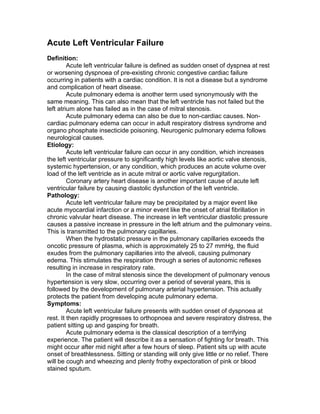Acute left ventricular failure is sudden worsening of dyspnea or congestive heart failure caused by conditions that increase left ventricular pressure like aortic stenosis or acute valve regurgitation. It leads to pulmonary edema as hydrostatic pressure in lungs exceeds plasma oncotic pressure, causing fluid to exude into alveoli. Patients experience terrifying breathing difficulties and pink frothy sputum. On exam, they are pale, sweaty and tachycardic with rales and S3 gallop, indicating severe dysfunction. Treatment focuses on oxygen, diuretics, morphine and positioning to relieve anxiety and dyspnea while reducing preload on the heart.



